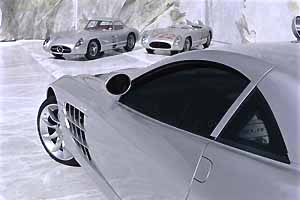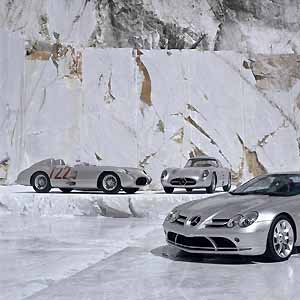
Mercedes-Benz
brings the acclaimed sports car back to life

Mercedes-Benz setzt die Sportwagen-Legende
fort |
The legendary SLR
-
The new Mercedes-Benz SLR McLaren celebrates its world premiere this
autumn
-
One-two victories in the Mille Miglia, Eifelrennen, Targa Florio and Tourist
Trophy
-
Rudolf Uhlenhaut developed the road-going SLR Coupé
 Juan
Manuel Fangio, Stirling Moss, Karl Kling - three of the men who wrote
motor-racing history. In the mid-1950s they all helped make the Mercedes-Benz
300 SLR one of the most successful racing sports cars of all time. With its
eight-cylinder, 2982-cc engine developing up to 310 horsepower, this Silver
Arrow was capable of a maximum speed in excess of 300 km/h - enough to power
it to glory in all the top road races of 1955. The Mille Miglia, Targa Florio,
Tourist Trophy, Eifelrennen and the Swedish Grand Prix - the 300 SLR won
them all. Rudolf Uhlenhaut (1906-1989), head of both passenger-car testing
and racing-car development at Mercedes-Benz at the time, proceeded to build
a road-going coupé version of this all-conquering racing machine.
The 300 SLR Coupé - better known to car enthusiasts as the "Uhlenhaut
Coupé" - incorporated the design and technology of the 300 SL Gullwing
produced from 1954 into the 300 SLR competition car. It first appeared on
the roads in 1955, turning heads wherever it went. The spirited lines of
the body, with its elongated bonnet, were complemented by the striking
proportions of the side-mounted exhaust pipes, the air vents and the wire-spoke
wheels. The cockpit, with its curved wraparound windscreen, was elegantly
sculptured. Rudolf Uhlenhaut referred to his latest automotive work of art
as a "hot-heeled touring car", and the 300 SLR Coupé lived up to its
billing. Weighing only 1117 kilograms yet developing 310 horsepower, the
"Uhlenhaut Coupé" accelerated to a maximum speed approaching 290 km/h
in testing (the manufacturer's data showed a top speed of 284 km/h). This
made the two-seater the fastest car of its time to be registered for use
on public roads, as well as "one of the most exciting cars that Mercedes-Benz
has ever built," as motorsport guru Karl Ludvigsen later observed. Juan
Manuel Fangio, Stirling Moss, Karl Kling - three of the men who wrote
motor-racing history. In the mid-1950s they all helped make the Mercedes-Benz
300 SLR one of the most successful racing sports cars of all time. With its
eight-cylinder, 2982-cc engine developing up to 310 horsepower, this Silver
Arrow was capable of a maximum speed in excess of 300 km/h - enough to power
it to glory in all the top road races of 1955. The Mille Miglia, Targa Florio,
Tourist Trophy, Eifelrennen and the Swedish Grand Prix - the 300 SLR won
them all. Rudolf Uhlenhaut (1906-1989), head of both passenger-car testing
and racing-car development at Mercedes-Benz at the time, proceeded to build
a road-going coupé version of this all-conquering racing machine.
The 300 SLR Coupé - better known to car enthusiasts as the "Uhlenhaut
Coupé" - incorporated the design and technology of the 300 SL Gullwing
produced from 1954 into the 300 SLR competition car. It first appeared on
the roads in 1955, turning heads wherever it went. The spirited lines of
the body, with its elongated bonnet, were complemented by the striking
proportions of the side-mounted exhaust pipes, the air vents and the wire-spoke
wheels. The cockpit, with its curved wraparound windscreen, was elegantly
sculptured. Rudolf Uhlenhaut referred to his latest automotive work of art
as a "hot-heeled touring car", and the 300 SLR Coupé lived up to its
billing. Weighing only 1117 kilograms yet developing 310 horsepower, the
"Uhlenhaut Coupé" accelerated to a maximum speed approaching 290 km/h
in testing (the manufacturer's data showed a top speed of 284 km/h). This
made the two-seater the fastest car of its time to be registered for use
on public roads, as well as "one of the most exciting cars that Mercedes-Benz
has ever built," as motorsport guru Karl Ludvigsen later observed. |
However, the lightning-fast SLR Coupé never made it into series
production. The Stuttgart-based car maker felt that the mid-1950s was not
the right time to bring out a powerful sports tourer of this kind, leaving
the road version of the SLR to fall into oblivion. As Mercedes pulled out
of motorsport in 1955, the SLR Coupé project was put on ice. Only
two prototypes of this masterpiece of power and elegance were ever built
and yet this wonderful car had still become a legend in its own right.
The Mercedes-Benz SLR McLaren:
State-of-the-art motorsport technology for the road
 The
new Mercedes-Benz SLR McLaren, which is set to celebrate its world premiere
in autumn 2003, revives the glorious tradition of the SLR and marks the
reawakening of Mercedes-Benz' passion for super sports cars. It is a passion
which can be traced way back through automotive history and which was
demonstrated with particular élan in the "Uhlenhaut Coupé".
A contemporary interpretation of stylistic elements lifted from the original
SLR and design details taken from the 2003 Formula 1 Silver Arrows allow
the 21st-century SLR to form a bridge between the past and the future, bringing
cutting-edge motorsport technology to the road, just as the inspirational
SLR Coupé did in 1955. The new super sports car allows Mercedes-Benz
and its Formula 1 partner McLaren to showcase their collective experience
in the development, construction and production of high-performance sports
cars. This combination of knowledge and expertise is evident not only in
the host of pioneering developments, impressive performance figures and superior
driving characteristics of the SLR, but also in the extremely high levels
of safety and practicality which it offers. These attributes come together
to form the basis for an automobile with a very special charisma - an impressive
synthesis of Mercedes tradition and innovation in every respect. The
new Mercedes-Benz SLR McLaren, which is set to celebrate its world premiere
in autumn 2003, revives the glorious tradition of the SLR and marks the
reawakening of Mercedes-Benz' passion for super sports cars. It is a passion
which can be traced way back through automotive history and which was
demonstrated with particular élan in the "Uhlenhaut Coupé".
A contemporary interpretation of stylistic elements lifted from the original
SLR and design details taken from the 2003 Formula 1 Silver Arrows allow
the 21st-century SLR to form a bridge between the past and the future, bringing
cutting-edge motorsport technology to the road, just as the inspirational
SLR Coupé did in 1955. The new super sports car allows Mercedes-Benz
and its Formula 1 partner McLaren to showcase their collective experience
in the development, construction and production of high-performance sports
cars. This combination of knowledge and expertise is evident not only in
the host of pioneering developments, impressive performance figures and superior
driving characteristics of the SLR, but also in the extremely high levels
of safety and practicality which it offers. These attributes come together
to form the basis for an automobile with a very special charisma - an impressive
synthesis of Mercedes tradition and innovation in every respect. |
Carbon-fibre and ceramic elements:
High-tech materials for the body and brakes
One example of the transfer of expertise from Formula 1 into sports-car
development is the series production of sophisticated carbon-fibre composite
materials in the construction of the chassis and body. This allows the new
Mercedes-Benz SLR McLaren to boast a level of rigidity and strength never
before achieved in road-going vehicles. Equally as exemplary is the level
of occupant protection: specially developed and exceptionally effective carbon
crash structures help the super sports car to set new standards in its vehicle
class in terms of energy absorption. The high-performance sports car's brakes
are also made from a new and innovative composite material. Fibre-reinforced
ceramics stand out with their extremely high heat resistance, outstanding
structural strength and long service life.
Meanwhile, under the bonnet lurks a V8 engine developed by
Mercedes-AMG and featuring state-of-the-art supercharger technology, which
delivers majestic torque and power development. Every SLR engine is built
by hand at the custom engine manufacturing facility.
READER COMMENTS
| DaimlerChrysler Communications,
June 02, 2003 |
BACK TO
TOP
|
